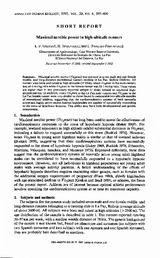Mostrar el registro sencillo del ítem
Maximal aerobic power in high-altitude runners
| dc.contributor.author | Greksa, LP | |
| dc.contributor.author | Spielvogel, H | |
| dc.contributor.author | Paredes-Fernández, L | |
| dc.date.accessioned | 2018-06-15T15:24:26Z | |
| dc.date.available | 2018-06-15T15:24:26Z | |
| dc.date.issued | 1993 | |
| dc.identifier.uri | http://repositorio.umsa.bo/xmlui/handle/123456789/16653 | |
| dc.description.abstract | Abstract. Maximal aerobic power (VO2max) was assessed in seven male and one female middle- and long-distance recreational runners residing in La Paz, Bolivia (3600 m). All runners were born and raised at high altitudes (> 2500). Mean VO2max in the male runners was 60.8 ml/kg/min while VO2max in the female runner was 55.5 ml/kg/min. These values are higher than in any previously reported sample of either trained or untrained high-altitude natives. In addition, mean VO2max in the La Paz male runners and VO2max in the La Paz female runner were very similar to those found in comparable low-altitude samples of recreational athletes, suggesting that the cardiorespiratory systems of both normally active and highly active native Andean highlanders are capable of successfully responding to the stress of hypobaric hypoxia. This ability may have both developmental and genetic components. | es_ES |
| dc.language.iso | en | es_ES |
| dc.publisher | Annals of Human Biology | es_ES |
| dc.subject | CORREDORES | es_ES |
| dc.subject | ALTURA | es_ES |
| dc.subject | POTENCIA AERÓBICA MÁXIMA | es_ES |
| dc.title | Maximal aerobic power in high-altitude runners | es_ES |
| dc.type | Article | es_ES |

